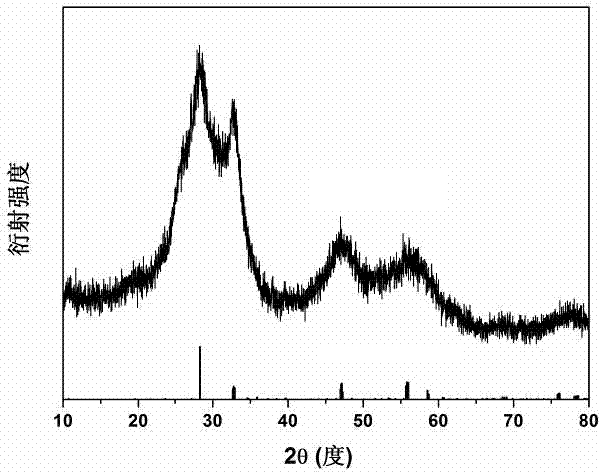Preparation method of bismuth tungstate quantum dot and preparation method of bismuth tungstate quantum dot-graphene composite material
A technology of quantum dots and bismuth tungstate, applied in the field of photocatalytic materials, can solve the problems of high surface energy and easy agglomeration of quantum dots, and achieve high photocatalytic activity, high stability, and strong controllability
- Summary
- Abstract
- Description
- Claims
- Application Information
AI Technical Summary
Problems solved by technology
Method used
Image
Examples
Embodiment 1
[0045] Dissolve 2.2mmoL sodium oleate in 20mL deionized water, add 0.194g Bi(NO 3 ) 3 ·5H 2 O, magnetically stirred for 1.5 hours to form an emulsion precursor solution;
[0046] Dissolve 10mg graphene oxide and 0.066g sodium tungstate in 20mL deionized water, stir for 1 hour and ultrasonically disperse graphene oxide evenly;
[0047] The two groups of solutions were mixed and stirred for 1 hour, then transferred to a 50 mL hydrothermal kettle, hydrothermally reacted at 160°C for 18 hours, and cooled naturally to room temperature;
[0048] The solid sample in the hydrothermal kettle is washed with n-hexane, ethanol, etc., and then vacuum freeze-drying technology is used to obtain a powder, which is a photocatalytic material composited with graphene and bismuth tungstate quantum dots.
[0049] figure 1 It is the XRD diffraction spectrum of the graphene bismuth tungstate quantum dot composite photocatalytic material obtained in this embodiment, and it can be seen through XRD...
Embodiment 2
[0058] The only difference between this example and Example 1 is that no graphene oxide is added in the preparation process. The rest of the content is exactly the same as described in Example 1. It is known from detection and analysis that the material obtained in this embodiment is bismuth tungstate quantum dots. Such as image 3 As shown, the size of quantum dots is about 3nm, and they spontaneously assemble into quantum wire structures. see Figure 4 The bismuth tungstate quantum dots obtained in this example have a degradation rate of 75% for rhodamine B under the same conditions as the composite material obtained in Example 1, which is lower than the performance of the composite material.
Embodiment 3
[0060] The only difference between this embodiment and Example 1 is that the emulsion-like precursor solution containing bismuth ions is made of 0.4mmoL BiCl 3 and 2.2mmoL sodium oleate dissolved in 20mL deionized water to form. The rest of the content is exactly the same as described in Example 1. After detection and analysis, it is known that the graphene bismuth tungstate quantum dot composite photocatalytic material obtained in this embodiment is an orthorhombic phase bismuth with a grain size of about 5 nm. 2 WO 6 The quantum dots are attached to large sheets of graphene. The graphene bismuth tungstate quantum dot composite photocatalytic material obtained in this example has a degradation rate of 65% for rhodamine B under the same conditions as in Example 1.
PUM
| Property | Measurement | Unit |
|---|---|---|
| Grain size | aaaaa | aaaaa |
| Concentration | aaaaa | aaaaa |
| Size | aaaaa | aaaaa |
Abstract
Description
Claims
Application Information
 Login to View More
Login to View More - R&D
- Intellectual Property
- Life Sciences
- Materials
- Tech Scout
- Unparalleled Data Quality
- Higher Quality Content
- 60% Fewer Hallucinations
Browse by: Latest US Patents, China's latest patents, Technical Efficacy Thesaurus, Application Domain, Technology Topic, Popular Technical Reports.
© 2025 PatSnap. All rights reserved.Legal|Privacy policy|Modern Slavery Act Transparency Statement|Sitemap|About US| Contact US: help@patsnap.com



